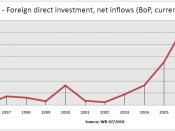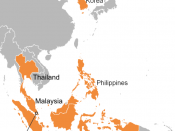Topic: Outline some of the recent and most salient trends and developments with regards to foreign direct investment worldwide and critically examine the determinants of inward foreign direct investment in China.
Part 1: Outline some of the recent and most salient trends and developments with regards to FDI worldwide.
Since the mid 1970s the amount of foreign direct investment (FDI) has been increasing at a fast pace. The world inward stock of FDI in 2003 was 22.9 percent in comparison to a mere 4.4% in 1960 (UNCTAD-DTCI 1994; cited in Ietto-Gillies 2005). The developing countries have the highest percentage of FDI, a testimony that FDI is a relevant element for developing economies. Over the last few decades, the composition and geography of FDI has undergone some major shifts as outlined below.
Trends in the Composition of FDIThe value of cross border mergers and acquisitions (M&As) rose to $716 billion in 2005, representing an 88 percent increase from the prior year.
Such levels border the first year cross border M&A boom in 1999. While the high level of M&As reflect strategic choices of transnational corporations (TNCs), it was also propelled by the recovery of stock markets, which in creating a steady investment climate, led to a large number of sizeable deals. The average transaction value of these deals is worth more than $1 billion (UNCTAD, 2006: 13).
Figure : Cross-border M&A sales for the world of purchaser, 1987-2005Source: UNCTAD, based on its on-line statistical database (www.unctad.org/fdistatistics).
A recent variation in the composition of FDI relates to that of collective investment institutions, namely private equity firms and hedge funds, which have emerged as prominent sources of FDI through cross border acquisitions.
Private equity funds focus primarily on "companies in distress, as well as in firms divested by large enterprises that prefer to...


